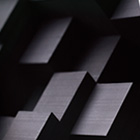Atomic power and nuclear fusion
High-temperature gas-cooled reactors
IG-110 is the world's only graphite material employed as components for high-temperature gas-cooled reactors (HTGR).

Graphite is very effective at slowing down fast neutrons to thermal neutrons, but is not very effective at absorbing neutrons. Thanks to its excellent thermal and mechanical properties at high temperatures, graphite is additionally used as a moderator and reflector in components in HTGRs.
Of the various graphite materials available, Toyo Tanso's fine-grained isotropic graphite, IG-110, provides excellent thermal durability, sufficient strength and highly consistent quality.
Due to the fact that it is availability of a large amount of outstanding data related to neutron irradiation damage, IG-110 is also currently the only graphite material employed in the world's three existing HTGRs*.
'*
- High-temperature Engineering Test Reactor (HTTR) (Japan Atomic Energy Agency)
- HTR-10 (Tsinghua University, China)
- HTR-PM (HTR project in Shangdong Province, China)
IG-430, a material that provides higher density, strength, and thermal conductivity, has already been developed as a graphite for next-generation HTGR, and is expected to be employed.
IG-110
- Proprietary data concerning neutron damage available
- Sufficient strength and consistent quality for standard values used in designs
- The only graphite used as a component material in an HTGR
*Photo courtesy of Japan Atomic Energy Agency
Nuclear fusion energy
CX-2002U (C/C composite) and IG-430U (isotropic graphite) are exceptional graphite materials that are capable of contributing to early practical applications of nuclear fusion energy--considered by many as the energy of the future.

CX-2002U is a high thermal conductivity material made from carbon felt infiltrated with pyrolytic carbon via chemical vapor infiltration (CVI).
It is a special material developed for use in diverters in nuclear fusion reactors, which require special heat-removal characteristics for plasma and ions/electron beam.
IG-430U is a type of isotropic graphite developed to provide higher density, strength, and thermal conductivity than IG-110, which has been used successfully in HTGRs. It is mainly used in the first walls of plasma facings exposed to low thermal loads.
CX-2002U
- Thermal conductivity of over 400 W/m·K, comparable to that of copper
- Excellent thermal shock resistance
- Anisotropic - Enables designs leveraging thermal and mechanical characteristics of anisotropic materials
- Widely used in nuclear fusion reactors in Japan and other countries around the world
IG-430U
- High-density isotropic material
- High strength
- High thermal conductivity (140 W/m·K)
*Photo courtesy of National Institutes for Quantum and Radiological Science and Technology



 YouTube Channel
YouTube Channel
 Carbon product FAQ
Carbon product FAQ
 Carbon ABC
Carbon ABC



